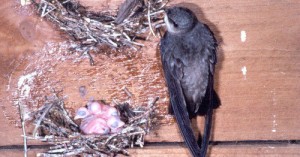What to Do if You Have Chimney Swifts
Chimney swift season is among us, and if your chimney is located on the eastern side of the United States and does not have a cap, chances are you might already have a nest. If this is the case, leave them be. Under the Migratory Bird Treaty Act, it is illegal to remove these specific birds from your chimney. Even a professional chimney sweep requires both a state and a federally-issued permit to remove them.
The good news is that by fall these birds will leave of their own volition to head to South America for the winter. Once they have vacated their nests, then it would be wise to call a chimney sweep for an inspection of any damage and to discuss installing a chimney cap to avoid this problem in the future.
Where Do Chimney Swifts Like to Nest?
Besides the obvious point of choosing a chimney for their nesting grounds, chimney swifts tend to prefer more urban and suburban areas where chimneys may be plentiful. When they nest and breed in rural areas, they are actually more prone to choosing either a hollow tree or cave.
The material of the chimney in question is also important. A chimney swift will only nest in a chimney made of stone, firebrick, or masonry flue tiles. Metal chimneys are unsuitable and actually dangerous as the chimney swift is unable to latch its claws onto the chimney wall and is more prone to getting stuck. Any animal for that matter, will fall to the bottom and be unable to get back out. This is one very good reason why all metal or pre-fabricated chimneys should be capped.
How to Spot a Chimney Swift?
It is actually tricky to get a good shot of a stationary chimney swift as they are always in flight unless roosting or nesting. However, if you want to be sure that one or more have taken up inside your chimney before deciding to take action or not, it is good to know what they look like.
- Cigar-shaped bodies
- 12 to 15 cm in length
- 27 to 30 cm wingspan
- 17 to 30 g (not that we expect you to weigh it)
- Dark, sooty olive plumage above and grayish brown below
- Black beak, feet, and legs
- Dark brown irises
- Short legs
- Will use claws to cling to the wall of the chimney instead of perching like most birds.
Living with Chimney Swifts
As the decline of chimneys and other natural habitats have affected the population of chimney swifts, many homeowners have opted to live with chimney swifts for the few months that they are in the area. The only downside is the loud sounds made by the babies when they are being fed, but after two weeks they will be old enough to feed themselves. Also, there will only ever be one active nest in any chimney at once.
Some homeowners have taken specific measures to add specific chimney caps to protect their home and chimney from water damage but that still allow access to the swifts during their visits.
Resources: All About Birds, The Humane Society, Old Hat Chimney Service, ChimneySwifts.org (2)
Wells and Sons provides chimney sweep services to the Gilbertsville, Boyertown, Pottstown, Allentown, Reading, and surrouding Pennsylvania areas. Services include chimney repair and chimney cleaning. Wells & Sons is also a full- service, masonry contractor company.









